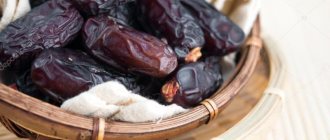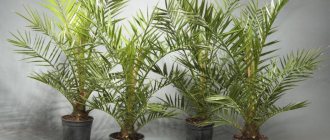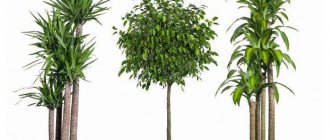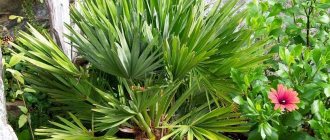What do we know about such amazing tropical plants? Is this a tree or a shrub? Where is their homeland? How to properly care for them? What do indoor flowers in the form of palm trees look like in the photo?
We hope that you will find answers to all these questions in our article.
general description
Palm trees are considered the most ancient plants that originally reproduced by seeds and pollen. Under natural conditions, they can reach up to 9 meters in height if growth is not artificially restrained. The size of a palm tree at home depends on care. The tallest palm tree in the world is the Wax Palm; its height can reach up to 50 meters. This tree is the main plant symbol of Colombia.
The name comes from the Latin word “palma”, which means “palm”. And this is not surprising, because the leaves of the plant really resemble splayed fingers on the palm of a person.
The flowering of an indoor palm tree is similar to the flowering of a calla lily.
For example, yucca has large white flowers that look like bells. Basically, the palm tree blooms with small yellow or white flowers on a small cluster.
I would like to remind you that it was not nature that created indoor plants for us, but we are trying to grow them in the hope that they will take root at home. Palma is no exception. There are several types that will feel great at home:
Appearance of the plant
On average, a palm tree lives about 150-200 years. For example, a coconut tree takes about 100 years to grow and produces about 450 nuts each year.
ON A NOTE! A coconut can travel thousands of kilometers through water, wash ashore, and germinate there.
There are 2 types of palm trees:
- With fan leaves. They diverge radially from the base. A prominent representative is the date palm.
- Cirrus. The leaves spread parallel to the sides from the vein in the center. A prominent representative is the bamboo palm.
Palms are perennial trees, less often shrubs, most of which have a non-branching trunk, at the top of which a crown grows. They can also grow as vines with thin stems. There are up to 1,500 species in tropical and subtropical areas.
Peculiarities
- The trunk of a palm tree usually does not branch (an exception is the genus of doom palms). Its thickness is about a meter, and during life it does not thicken. Among the palm trees there are climbing vines, the stems of which are about 2-3 centimeters thick and up to 300 meters long.
- The inflorescence of a palm tree is a spadix that is of impressive size and branches. Flowers are located on the branches, sometimes they are immersed in its tissue. All inflorescences are surrounded by a veil.
- What fruits grow on a palm tree? They can be in the form of a nut or a bone or a berry. Ornamental palms produce fruits in the form of small round berries.
Classification and types of palm trees
The Palm family has more than 200 genera and almost 3,500 species. Among the most famous “wild” representatives are Coconut, Bismarckia, Sabal, Roystonea, Date, Eleis, Mauritia, Sabal, etc.
Among those grown at home, mention should be made of Howea, Washingtonia, Areca, Livistona, Date, Cycas, Hamedorea, etc.
Palm trees can be classified by the type of leaves they have. The leaf blades are fan-shaped and pinnate. Also, plants of this family are conventionally divided into tropical and subtropical. Subtropical ones are considered more hardy. They adapt better to home conditions and tolerate wintering well.
INTERESTING. Representatives of this family can be not only trees, but also vines. There are also rhizomatous palms (Chamedorea).
Exotic varieties
Let's talk about the types of exotic palm trees and how they bloom.
The most common include:
- Brachea. Loves light, but grows best in partial shade. Can't do without spraying. Watering is moderate.
- Boothia. A palm tree whose leaves resemble feathers. Blooms in late spring.
- Washingtonia. Fan palm, pleasing the eye with white blossoms. Can reach a height of up to 18 meters.
- Giophorba. The young representative resembles a vase in appearance. It blooms with small flowers and smells pleasant.
- Hamedorea. It is considered the most unpretentious species and tolerates shade well. Blooms almost all year round.
- Kariota. The leaves of the plant look like a fish tail. It blooms once a year for 5-6 years.
- Liviston. The leaves look like an open fan, reaching a height of up to 2 meters. Ideal for rooms.
- Rapis. It grows as a shrub. Very whimsical.
- Chamerops. Massive palm tree with a dense crown. Blooms from April to June.
- Yucca. A tree-like plant whose leaves are collected in bunches. The white flowers look like bells.
- Govea. An elegant plant reaching a height of up to 2.5 meters. Requires careful care.
- Date palm. The most common species, grows as a lush shrub.
- Sabal. A plant with fan-shaped leaves. The types of palm trees growing in the rooms are absolutely different from each other.
- Trachycarpus. It reaches a height of up to 2.5 meters and grows very slowly. Suitable for apartments.
What palm trees can you grow at home?
Of the entire generic and species diversity, approximately 20-30 varieties of these plants are cultivated indoors. Below are the most popular ones.
Areca
Tree or bush palm. It can grow with several trunks at once.
The leaves are long, dissected into 50-60 pinnate segments. It grows strongly with age.
In room conditions it can grow up to 3 m. It does not bear fruit at home.
The most popular varieties are Three-stanched, Catechu, and Yellow.
Brachea
A palm tree with a grayish trunk and a lush crown of fan-shaped leaves with flat, sharp segments.
The petiole is strewn with thorns.
The color of the leaf blades is pale with a grayish or bluish tint. It is a slow-growing, hardy plant.
The most popular varieties of Brachea are Armed, Brandegi, Edible.
Washingtonia
A tree thinning towards the top.
The leaves are fan-shaped. They grow with a lush crown. The segments of the leaf plates are hard and pointed.
After 10-15 years of growing in an apartment, it may bloom.
Likes relative coolness. In adulthood, it can be transplanted into a greenhouse.
In culture, 2 varieties are most often found: Filamentous and Robusta.
Giophorba
There are names like Mascarene and Bottle Palm.
It has a bottle-shaped trunk. The leaves grow on reddish petioles. Rarely seen. It is considered an elite plant. It has a compact size relative to other palm trees.
Bottle-stem Giophorba, Verschaffelt Giophorba and Indian Giophorba are grown indoors.
Zamia
False palm from the Zamiaceae family.
A low, palm-like plant with a short trunk and feathery leaves. Fragments of leaf plates are oval.
There are varieties: False-parasitic, Powdered, Broad-leaved.
Tolerates short periods of drought and exposure to direct sunlight.
Palma Butia
Butia Capitata is grown indoors, which is distinguished by its thickening at the base of the trunk.
Loves moderate warmth; in winter it requires a period of rest and a decrease in temperature. It is considered one of the hardiest plants in the family.
Found on the Black Sea coast of Russia.
INTERESTING. In the wild it bears fruit. The fruits are harvested on an industrial scale in South America.
Palma Kariota
A bushy plant with leaves atypical for palm trees. The shape of the leaf plates is similar to the tails of fish. The leaves grow from petioles that can be mistaken for twigs.
The most popular varieties are tender Kariota and burning Kariota.
Even in indoor conditions it easily grows to the ceiling.
Liviston Palm
A relatively low palm tree with oval leaves. The segments fit tightly to each other and diverge only towards the sharp tips.
It is considered a slow growing tree.
The most popular types are Chinese, Southern, Deceptive.
Palma Licuala
Dwarf plant. It has a thin trunk with a slight thickening at the base.
Leaves without segments, with serrated edges. The shape of the leaf plates is similar to a fan or bird's wing.
At home, Likuala Majora is mainly grown.
INTERESTING. With proper care, the leaves of this tree do not fall down like other members of the family, but rise up.
Pandanus
False palm from the Pandanaceae family.
It is distinguished by a short trunk and long leaves pointed at the end. The leaf blades are covered with hooks, and the central vein, protruding from the underside of the sheets, is covered with spines.
The most popular types are Veitcha, Sandera, Pandanus useful.
Rapis
Grows in several thin trunks.
It has a lush crown, which is formed by loose leaves. Fragments of leaf blades are lanceolate, elongated.
The leaves themselves look like an outstretched palm. Grows no more than 1.5 m.
Trachycarpus
A tree with a “hairy” trunk and leaves growing on long triangular petioles.
The leaf blades are directed upward and look like the wings of birds.
At home you can grow the following varieties: Fortune, Wagner, Martius.
Date Canary
At home, it has a shortened trunk covered with petioles of dried leaves. Because of this, the trunk of the Canary Date resembles a pineapple half buried in the ground. Loves sunlight.
In summer, it is advisable to take it out onto the balcony or into the garden.
It is necessary to ventilate, and in winter to supplement the light with phytolamps.
Date Robelena
It is considered one of the shortest palm trees.
It has a lush crown and delicate soft leaves. The trunk is medium thick. Purifies indoor air.
Leaf color may vary depending on lighting. The tree can be grown from seeds at home.
Date palm (Phoenix palm)
Grows with one or several trunks.
The leaves are pinnate with pointed segments. Refers to perennial plants.
Capable of living for several decades in captivity.
Most often sold in flower shops is the Common Date. Can be sprouted from seed.
Hamedorea
There is a name Bamboo palm.
It grows in several thin trunks, similar to bamboo. The segments of the leaf blades are sharp, sword-shaped, located far from each other. Because of this, the crown of the plant does not seem lush.
Detailed information about care is presented in our article “Chamedorrhea: care at home.”
Chamerops (fan palm)
A bushy plant with a wide cap of hard, narrow leaves on petioles studded with hooks.
Grows with several trunks. The plant can tolerate temperature fluctuations.
Hamerops Squat is grown at home.
Hovea
The name Govea appears. A smooth-bore tree with clearly visible “rings” on the trunk.
The leaves are large and feathery. The segments are xiphoid.
There are 2 varieties cultivated at home: Forster and Belmore.
In an apartment it can grow up to 2-3 m. It tolerates shade well. In winter it is kept at a low temperature (about 15 degrees).
Chrysalidocarpus
Areca variety. Grows as a bush. At home it can grow up to 2 m.
The young plant has a yellowish tint to the shoots and petioles.
The leaf segments are lanceolate, narrow and pointed. The most popular varieties are Yellowish and Madagascar.
Tsikas
The name "Sago Palm" may also occur. Is a false palm.
Represents the Cycad family. Home-grown varieties of Cycas have a short, thick trunk from which leaf petioles grow.
Leaf blades consist of needle-like segments.
The most common are Cycas drooping, Cycas Snail-shaped, Cycas Medium, Cycas Rumpha, Cycas Siamese.
Where is your homeland?
The tropics and subtropics are considered to be the homeland of the palm tree. These zones are the native habitat of trees. Where do they usually grow? Most often they can be found in Africa and Eurasia, as well as some regions of Central Asia.
The plant has become widespread in many regions of the globe. They are more often found on the shores of tropical seas, high in the mountains and in humid forests. A huge number of species grow in Colombia and Madagascar. The fan palm is more common in Spain. The feathery representative can be seen more often in Greece.
Also, some species grow in the territory of the former Soviet Union, for example, on the southern coast of Crimea.
You can see what a flower in the form of an indoor palm tree looks like in the photo here. Howea Forster
Hamedorea
Rapis
Brachea
Washingtonia
Giophorba
Kariota
Liviston
Hamerops
Yucca
Date palm
Sabal
Trachycarpus
Humidity and watering
The main principle of care is regular watering of palm leaves. This procedure is no less important than watering. It is noteworthy that the palm tree can survive for quite a long time without proper watering, but it definitely cannot tolerate dry air and will die.
In summer, this crop requires watering twice a week. It should be done using warm water. In winter, when the room is heated, spraying should be done daily. It should be noted that it is best to irrigate the palm tree with distilled water, since running tap water contains chlorine impurities, which will damage the leaves and leave whitish marks on them.
Leaf plates are sprayed both from the surface and from the inside. The palm tree requires moderate watering to keep the soil slightly moist. During the growing season, the plant requires more intensive watering, which should be done on a daily basis. During the winter months, the palm tree requires less water, so it is watered no more than three times a week. It is noteworthy that for irrigation, as well as for spraying, you cannot use tap water, but only distilled water.
What kind of care does it require?
Growing an exotic plant at home is not so easy. It needs proper care:
- It is recommended to place the pot with the plant on the south side of the house.
- In summer, the temperature should range from 16 to 20 degrees Celsius.
- In summer, be sure to moisturize the crown.
- From early spring until late autumn, a palm tree blooming at home needs abundant watering. Drying out the soil is unacceptable.
- Green beauties love light very much, but they cannot be exposed to direct sunlight.
- The plant is afraid of drafts.
- The soil for growing should be light and flat.
- Palm trees need regular feeding and fertilizer.
Palm tree care at home
Planting and caring for a palm tree is not particularly difficult. Whenever possible, palm trees are planted in winter gardens. Optimal conditions for house plants are created here. When purchasing an adult seedling, the risk of disease and death is taken into account. Sudden changes in the environment have a detrimental effect on the plant. However, it will not be difficult to grow a palm tree from a small sprout.
The genus of palms belongs to hydrophilic plants. In nature, they grow near water sources. The main feature is that even in severe drought they can exist for a long time without moisture.
Although the plants do not require special care, when growing at home, few people have seen a palm tree bloom. They rarely produce inflorescences and bear fruit even less often. The Asian palm and date palm do not bloom at all, because this is due to their physiology.
Watering
Palm trees need to be watered promptly and often. The soil should not dry out. In the winter months, the amount of watering is reduced. At this time, the soil is moistened once every 2 days. In summer, palm trees need to be watered daily.
If the temperature in the room where the seedling is growing does not exceed 7 °C, watering is carried out 2 times a month. If necessary, spray the above-ground part instead of moistening the soil.
It is recommended to make drainage at the bottom of the pot so that the moisture does not stagnate.
Settled water is used for irrigation. After moistening, the soil must be loosened.
Top dressing
Indoor palm trees need fertilizer to form healthy roots and grow green mass. The main components of the additives are phosphorus and nitrogen. Fertilizers can be purchased ready-made in specialized stores and used according to the instructions, for example, “Green Paradise”, “Kristalon”.
You can prepare the fertilizer yourself. The simplest option: make a solution from a tablespoon of wood ash and a liter of water. The product is used throughout the growing season at intervals of 7-10 days.
Weakened plants are fed with a solution of dry yeast.
To do this, dissolve a tablespoon of yeast in a liter of water and leave for an hour. The finished product is diluted with 5 parts of water and watered over the plants. Potato starch is used using the same method. It is also recommended to use chilled potato broth for watering, which is formed after boiling the root vegetable.
Orange and banana peels are used for feeding. They are mixed with a few teaspoons of sugar and poured with water, keeping the proportion: 2 fruits per 3 liters of water. The solution is infused for 3 weeks in a dark place. The finished products are filtered and diluted with water in a ratio of 1 to 20. This fertilizer is used to water the plants once a month.
Temperature
Ornamental palms thrive at temperatures from 16 to 22 °C. In winter, this figure drops to 8-10 °C. Asian palm, coconut, Hamedorea, Areca and other heat-loving species are kept in winter at temperatures from 14 to 16 ° C.
Trimming
Leaves of indoor palm trees are not trimmed. This can lead to plant disease.
Only yellowed and dried leaves are removed. With normal growth, palm trees turn yellow and only the lower leaves wither. If this happens to the top ones, the plant is not being properly cared for or is sick. It is not recommended to shape or shorten the crown, since palm trees have only 1 growth point. If interfered with, the plant may die.
Transfer
It is recommended to replant the palm tree in the spring. These plants require nutritious soil. The substrate can be purchased in specialized stores or prepared independently. Composition of nutrient soil: 2 parts each of clay-turf and humus-leaf soil, 1 part each of peat, humus, sand, a small amount of wood ash.
Young plants, no more than 3 years old, are replanted once a year. An adult indoor palm tree needs to be replanted every 3-5 years.
A drainage layer is made in the pots. The material is mixed with charcoal. When replanting, monitor the roots of the plant so as not to damage them. When removing it from the old pot, they try to remove the root system along with the earthen lump.
Palm trees require tall pots.
After transplantation, the plants must be fed. To do this, use organic additives necessary for better rooting and further growth of seedlings.
Reproduction
The domestic palm tree is capricious when propagated indoors. Plant seeds are sown in February or March.
Purchase planting material from specialized stores.
If the seeds were fresh, shoots will appear within 20-30 days. Otherwise, seedlings will appear after 2-4 months.
The seeds are poured with water, preferably warm, and left for 3-4 days. If the planting material is large, it is trimmed. Small pots are required for sowing seeds. Planting material is deepened in them by 2-3 cm. The distance between plantings should be at least 3 cm. Seeds are germinated at a temperature of 20-22 or 28-30 ° C. It all depends on the variety.
The soil must be moistened and covered with film. The container is periodically opened for ventilation and watering. When the seedlings grow to 10 cm, they are transplanted.
You can also propagate a bush palm tree at home using the root method; for this, the tree is removed from the ground and a sprout with a complete root system is separated from it. The cut is made with a sharp knife and subsequently treated with crushed activated carbon. The new plant is planted in a separate container.
Pests and diseases
The palm tree reacts to improper care. This is manifested by deterioration in appearance or various diseases.
Excess or lack of moisture leads to yellowing of the foliage. The above ground part may turn brown.
When the air is dry, the tips of the leaf blades begin to dry out. With high humidity, fungal diseases appear. They appear as spots on the leaves. To combat fungal diseases, remove the affected parts, reduce the temperature, and reduce the amount of watering. If fungal spores are in the soil, the palm tree is replanted. At the same time, treat both the plant and the soil with fungicides.
The most common disease of palm trees is root rot. When affected by it, the plant does not develop and practically does not grow, some sections of the roots die off, and the above-ground part turns yellow. The affected areas are removed, and the roots of the plant are placed in the “Chomecin” solution. After 15 minutes, the treated areas are sprinkled with activated carbon, and the plant is replanted.
Mealybugs, scale insects, and spider mites are considered dangerous pests for palm trees. To control pests, plants are treated with insecticides.
Distribution[edit | edit code ]
The natural distribution area of most palm trees is the tropics and subtropics. Especially many types of palm trees grow in Madagascar and Colombia. In Europe, in Spain and the south of France, the fan palm Chamaerops humilis
), which can withstand frosts down to −12 degrees Celsius, and also in the south of mainland Greece and Crete there are groves of the feathery Cretan date palm (
Phoenix theophrastii
).
Chamaerops grow on the territory of the former USSR in areas with a subtropical climate - on the Black Sea coast of the Caucasus and the southern coast of Crimea, as well as in Azerbaijan and Georgia.
,
Phoenix
,
Sabal
,
Trachycarpus
,
Washingtonia
and some others.
Required temperature and room features
The palm tree is a representative of tropical fauna, and therefore, in indoor growing conditions, it also requires heat. Optimal conditions for species such as Hamerops, Trachycarpus, Washingtonia will be a temperature of 15 degrees. Absolutely all types of this crop do not like drafts, and the root system is vulnerable to cold, so it is not recommended to place the container with the plant on a cold floor or an unsealed windowsill. The ideal option would be the corner of a warm, well-lit room.
Article on the topic: Macadamia description and features
Biological description [edit | edit code ]
The trunk usually does not branch (except for the genus of doom palms), quite often palm trees have the appearance of shrubs, some representatives do not have any stems at all, only leaves rise above the surface of the ground. The thickness reaches 1 meter (yubeya), the height is up to 50-60 m (ceroxylon), while among the palm trees there are climbing vines with stems 2-3 cm thick and up to 300 m long (rattan). The leaves are either pinnate (coconut palm, date palm, foxtail palm, Howea, Hamedorea, etc., in Caryota they are bipinnate) or fan-shaped (Chamerops, Trachycarpus, Liviston palm, etc.).
Flower formula: ∗ C a 3 C o 3 A 3 + 3 G ( 3 ) _ <3>;Co_<3>;A_<3+3>;G_<(3)>>> [4] .
Diseases and pests
In general, palm plants are quite resistant to diseases and attacks by insect pests. However, illnesses can occur. Let's look at the main ones.
The diseases are:
- Leaf spotting . The disease is a consequence of improper watering, high humidity or hypothermia. Caused by a fungus. Control measures: reducing watering, treating leaves with fungicides.
- Palm penicillosis. It appears as spots on the upper leaves, which are then covered with a white coating. Caused by a fungus. Fungicides and removing damaged leaves help.
- Root rot occurs due to stagnation of water in the pot and contaminated soil. The disease progresses very quickly. The leaves darken and the roots die. Root rot is difficult to treat.
There are also diseases that are caused not by the action of fungi, but by improper care. They most often appear as wilting of leaf tips. In this case, you just need to create conditions suitable for palm trees.
The most damaging insect pests
- Mealybug. The action of the parasite affects the growth and appearance of the plant.
- Shield . The insect damages the leaves, which take on ugly shapes.
Insecticides Vertimek, Fitoverm, etc. will help you cope with parasites. You can also use folk remedies. For example, garlic infusion or ammonia.
Common types of palm trees: detailed description, name and photo
About 20 species of palm trees are now grown in indoor floriculture. These plants are becoming increasingly popular. Their decorative qualities are highly valued.
Indeed, palm trees look unusual against the backdrop of snowdrifts outside the window; they have an interesting shape of leaves and trunks.
In addition, some of them can grow in partial shade, this allows you to create interesting corners in the apartment, the center of which is a palm tree.
With their help, verandas and loggias are landscaped. Even in places with harsh winters, they become an integral part of the garden in the summer; they are taken there directly in tubs.
You will learn about what types of indoor palm trees there are, their names and photos, as well as what the generic name of the plants of the family is in this article.
Palm fertilizer
Fertilizing is used in cases where the plant is healthy and is in a period of growth, not dormancy. Fertilize palm trees after 2-3 weeks with fertilizers for decorative deciduous plants.
Fertilizing is carried out only after the earthen ball has been watered and saturated with water. You can feed with any commercial fertilizers suitable for palm trees, for example, “Ideal”, “Uniflor-rost”, “Tsniflor-micro”, “Giant”, etc. Do not feed palm trees in autumn and winter, as well as the first two months after transplanting into fresh land.
Hygiene
To prevent attacks by thrips, aphids and other pests, it is necessary to periodically wipe palm leaves with a damp sponge, and small plants can be immersed with leaves in warm water with a solution of Persian chamomile or green soap. After 30 minutes, the plant must be washed with clean warm water. Palm trees are sprayed regularly, taken out in the rain in the summer, or at home under the shower, if the size of the plant allows.
Fruits of palm trees
The palm tree is one of the most useful plants for humans, because many of its varieties produce very tasty and even medicinal fruits: dates, coconuts, etc. Flour, oil, alcoholic drinks are made from them, fibers are also produced on an industrial scale, from which bags and other fabric products.
The most beneficial fruits for humans that grow on palm trees are dates and coconuts.
The date is a cylindrical berry with a thin peel; its average weight is 7 g, of which 2 g is per seed. The sugar content in it reaches 70%, calorie content - 30 kcal/piece. 10 dates a day provide the daily need of the human body for magnesium, sulfur, copper, iron and a quarter of calcium.
Many tasty and healthy ingredients are extracted from coconut:
- juice or water - a clear liquid, the endosperm of a coconut, contained inside the fruit; as it ripens, it mixes with oil and hardens;
- coconut milk - obtained after squeezing grated copra, it is white and quite fatty, after adding sugar it is very tasty;
- oil - extracted from coconut copra, is a valuable product due to its high content of fatty acids, used in cosmetics and treatment.
Lighting and air temperature
Caring for the betel palm is quite difficult; it requires ideal growing conditions. Lighting should be diffused so that the plant does not suffer from burns - up to 6 years old, palm trees are especially susceptible to bright light. To form a crown of the correct shape, it is recommended to periodically rotate it relative to the light source.
Since the betel palm is a tropical plant (its homeland is the Philippines, Madagascar, Indonesia and Fiji), it loves high temperatures - about +30 degrees. In a temperate climate, it is practically impossible to create such conditions all the time, except in the summer. Therefore, it is important to protect the tree from low temperatures - reduce the amount of ventilation in winter and prevent the plant from being in a draft.
The palm tree loves high humidity, so it is recommended to periodically spray the leaves with a spray bottle. This advice is especially relevant in the summer.










